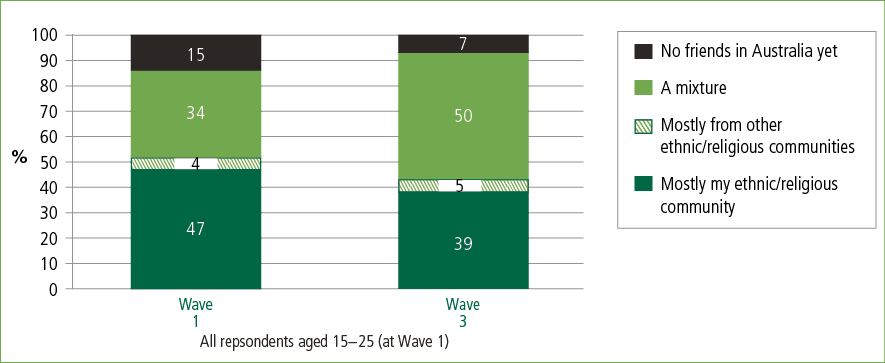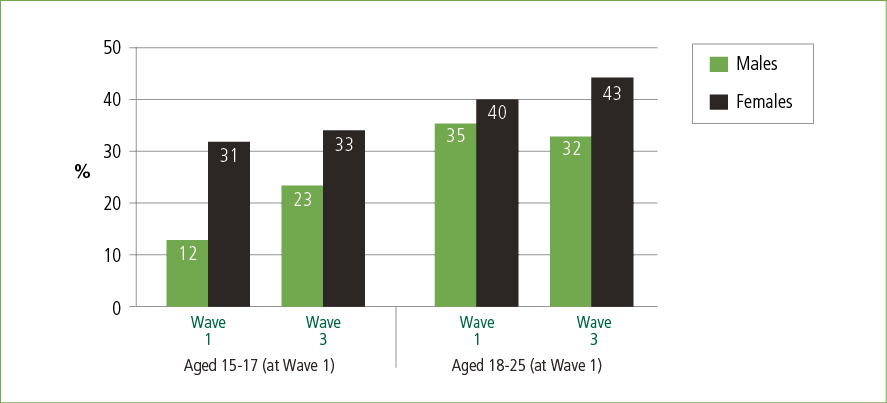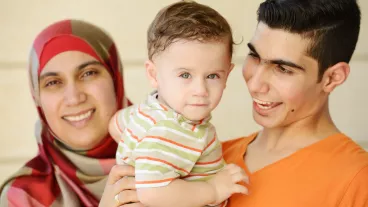Settlement outcomes of humanitarian youth and active citizenship
Economic participation, social participation and personal wellbeing
Download Research snapshot
Overview
This research summary reports on how young people aged 15-25 years old from humanitarian backgrounds are settling in Australia. We use data from the Building a New Life in Australia (BNLA) study, and make reference to the National Youth Settlement Framework, developed by the Multicultural Youth Advocacy Network (MYAN) Australia. At November 2016, there were 14,100 young people in Australia who had recently arrived on a humanitarian visa (Australian Bureau of Statistics [ABS], 2017)1.
1 Based on age at survey (15-24 years) and visa on arrival. The definition of 'recent arrival' includes being a permanent resident and having arrived in Australia since 2006.
Key messages
-
Young people from humanitarian backgrounds improve their English language skills and increase their participation in study or training over time.
-
Women aged 18-25 are lagging behind men and adolescents in their English proficiency. Targeted approaches are needed to support young women to improve their English skills.
-
Young people's social networks in Australia show increased integration over time.
-
Participants report higher levels of discrimination with longer time in Australia. Given the negative effects of discrimination on wellbeing, ways need to be found to address discrimination at the personal, community and institutional levels.
-
Young people in the BNLA show high levels of psychological distress - higher than in the general population. Addressing pre-migration trauma as well as settlement stressors relevant to young people is necessary to help improve mental health outcomes in this population.
Background
Young people from humanitarian backgrounds have enormous potential to actively participate in Australian society. This group of young people come to Australia with an array of strengths, including being multilingual, having well-developed cross-cultural skills and global networks, and having strong aspirations to achieve educationally and contribute to Australian society. However, they can face a range of challenges, including negotiating the developmental tasks of adolescence and the transition to early adulthood, developing new peer networks, understanding the service system and adjusting to often new family dynamics after settling in Australia. Young people who have experienced trauma or loss may also find their capacity to achieve developmental goals diminished by their pre-migration experiences and the challenges of settling into a new country (MYAN, 2016).
Young people experience settlement in ways distinct from children and adults due to their age, developmental stage, and the role they commonly play in supporting their family to settle.
In 2016, MYAN developed a National Youth Settlement Framework (NYSF) to guide settlement policy and service delivery for this population. The goal of the framework is to promote active citizenship in four domains: economic participation, social participation, civil participation and personal wellbeing. These domains and indicators are supported at the service delivery level by a set of eight good practice capabilities (see Box 1 for more information).
Box 1: The National Youth Settlement Framework
The NYSF aims to address the particular needs of young people from refugee and migrant backgrounds during their settlement journey. These needs are different from those of children, adults and families, given the critical life stage of adolescence and the developmental tasks of negotiating belonging and identity. The framework was informed by young people and those working with refugees and migrants in the non-government and government sectors. A practical resource, it provides evidence-based guidance for supporting and measuring good practice on settlement outcomes, involving all areas of young people's engagement with services to support their settlement in Australia.
Access more information about the National Youth Settlement Framework [PDF.
This research summary makes reference to the NYSF by exploring how young people in BNLA are doing in three of the domains. Settlement outcomes are examined for economic participation (English language and study and training), social participation (social networks and discrimination) and personal wellbeing (mental health).
BNLA is a useful resource for studying the settlement outcomes of young people, with 134 adolescents aged 15-17 and 546 young adults aged 18-25 interviewed at the first wave of the study, of which 104 and 352, respectively, have completed interviews in each of the first three annual waves of the study, analysed here.2 These young people are the focus of this research summary. For more information about BNLA and the sample of young people, see Box 2.
2 Analyses are based on a balanced panel when three waves of data are presented; that is, these analyses include respondents who completed three waves of data. Longitudinal weights are used in analysis of multiple waves. Cross-sectional weights are used in analysis of one wave.
Economic participation
English language skills and education provide opportunities for participation and are critical for young people to build pathways to employment. The NYSF highlights the importance of these areas in the process of settlement.
English language proficiency
Learning English is essential for humanitarian migrants to be able to settle and participate successfully in Australia. Figure 1 shows that with longer time in Australia, young humanitarian migrants significantly improve their English-speaking proficiency; the percentage of young people who speak English well or very well increases with subsequent waves of BNLA.3 Respondents who were adolescents at Wave 1 (aged 15-17) improved their English more than those who were young adults (aged 18-25); even though these age groups were not significantly different in their English proficiency pre-migration (self-assessed at Wave 1), adolescents' proficiency is higher than that of young adults in later waves.
Box 2: Building a New Life in Australia
BNLA data collection
BNLA is a longitudinal study of humanitarian migrants who arrived in Australia or received their permanent visa between May and December 2013 (n = 2,399). The study aims to identify factors that help or hinder successful settlement and to help inform policy development and program delivery for humanitarian migrants (for more details on the BNLA study, see Jenkinson, Silbert, De Maio, & Edwards, 2016, and De Maio, Silbert, Jenkinson, & Smart, 2014). The first wave of data was collected between October 2013 and March 2014. Participants have been interviewed annually since then.
Data for Waves 1 and 3 were collected using face-to-face interviews while Wave 2 interviews were conducted over the telephone. A different pattern of responses was observed in Wave 2 regarding mental health, which may be due to the different interview mode. For this reason, Wave 2 data are not reported for this outcome.
Young people in the BNLA sample
In the initial BNLA sample 51% of young people were men and 49% were women. These young people have diverse backgrounds: the most common countries of birth are Iraq (29%) Afghanistan (20%) and Iran (14%), and the languages most frequently spoken are Arabic (18%), Persian (15%), Assyrian Neo-Aramaic (13%), Nepali (10%), Hazaraghi (10%) and Dari (9%).
There was also considerable diversity in the young people's family arrangements on arrival in Australia. Of young people aged 15-17 years at the time of the first interview, 65% arrived with two parents, while the remaining 35% came with a single parent. Compared with 15-17 year olds, a lower proportion of participants aged 18-25 arrived in Australia with two parents (40%), a further 13% arrived with a single parent, and 9% were in other family arrangements (such as with other immediate family members). Unlike the younger humanitarian migrants, 38% of those aged 18-25 arrived as a single person.
Adolescent males and females had similar levels of English-speaking proficiency pre-migration and over time. Among young adults, however, men showed higher proficiency pre-migration and at all waves compared with women (not shown in Figure 1).
Adolescents' and young adults' participation in education is presented in Figure 2. As the younger cohort includes those still in school, a higher proportion of adolescents were engaged in study or training compared with young adults at each wave. However, the vast majority of both adolescents and young adults had undertaken English classes since arriving in Australia. English study was more common at Wave 1, while both age groups increased their participation in other study or training as they spent more time in Australia. There were no significant differences in overall participation in education by sex.
It is important to note that even though young adults had lower participation in study or training, they were more likely to be in paid employment compared with adolescents (31% vs 6% at Wave 3). However, this applied mainly to men, with 49% of young adult men in paid work at Wave 3 compared with 8% of women. There were no differences in the percentage of women employed between age groups.
Figure 1: Young people's English-speaking proficiency over time, by age group

Source: BNLA, respondents in Waves 1-3, aged 15-25 at the time of the first interview (Wave 1).
Figure 2: Young people's participation in English classes and other study or training over time, by age group

Notes: Other study or training includes work experience (unpaid experience in a workplace), paid traineeship, secondary school (Years 7-12), short course (1-6 weeks), trade or technical qualification (1-3 years) and university degree. It excludes English classes.
Source: BNLA, respondents in Waves 1-3, aged 15-25 at the time of the first interview (Wave 1). Study or training undertaken at the time of the interview or between waves (since arrival for Wave 1).
3 English language skills were self-assessed at each wave.
Personal wellbeing
Mental health
An important aspect of personal wellbeing is mental health. Research has shown that humanitarian migrants generally have higher levels of mental health problems than other groups in the host country (e.g. De Maio, Gatina-Bhote, Rioseco, & Edwards, 2017; Fazel, Wheeler, & Danesh, 2005). Mental health problems in this population are related to pre-migration traumatic experiences (e.g. Mollica, McInnes, Poole, & Tor, 1998; Nickerson, Bryant, Steel, Silove, & Brooks, 2010) and stressors associated with the process of settlement, including unemployment, financial stress, difficulties with language and discrimination (e.g. Chen, Hall, Ling, & Renzaho, 2017; Nickerson et al., 2010). However, little research has focused specifically on young people from refugee backgrounds.
The BNLA study shows that adolescents and young adults have high levels of psychological distress, with 31% of men and 37% of women classified as having moderate/high psychological distress (at Wave 1).5
National data from the ABS National Survey of Mental Health and Wellbeing (ABS, 2008) shows much lower proportions of moderate/high psychological distress in the Australian population as a whole aged 16-25 years, with 5% of men and 12% of women in this category.
Figure 3: Young people's friendship networks in Australia at Wave 1 and Wave 3

Notes: This survey question was not collected in Wave 2.
Source: BNLA, respondents in Waves 1 and 3, aged 15-25 at the time of the first interview (Wave 1).
Figure 4: Young people who reported experiences of discrimination in Wave 1 and Wave 3, by age group

Notes: Difference between waves significant for respondents aged 18-25. Wave 2 data is not presented as adolescents aged 15-17 were not asked this question in Wave 2.
Source: BNLA, respondents in Waves 1 and 3, aged 15-25 at the time of the first interview (Wave1).
Figure 5: Percentage of young males and females classified at moderate or high psychological distress, by wave and age group
Notes: Wave 2 data are not presented as the mode of data collection was different to Waves 1 and 3 (telephone vs face-to-face).
Source: BNLA, respondents in Waves 1 and 3, aged 15-25 at the time of the first interview (Wave 1).
We also find the following significant differences (Figure 5):
- Among adolescents, a higher proportion of females had moderate/high levels of psychological distress in Wave 1 compared with males.
- A smaller proportion of adolescents were classified as having high/moderate psychological distress compared with the full BNLA sample (39% men and 46% women at Wave 1, see De Maio et al., 2017).
- Young adult females had higher levels of psychological distress than males in Wave 3.
5 See Kessler et al. (2003) and Hilton et al. (2008) for further details on this measure and the scoring of the Kessler 6.
Summary
This research summary presented new findings on settlement outcomes of young people in three domains from the NYFS that contribute to active citizenship: economic participation, social participation and personal wellbeing, using data from the BNLA.
- Young people showed significant improvements over time in two indicators of economic participation in the NYFS - acquiring English language skills and engaging in education and training.
- Women aged 18-25 are lagging behind men and adolescents in their English proficiency, and may need targeted support to improve their language skills.
- Regarding the NYFS' social participation indicators, young people's social networks show increased integration with time in Australia. However, young participants report higher levels of discrimination in later waves. Experiences of discrimination can have negative effects on health and wellbeing. These findings indicate the need to work with communities of all ages to reduce discrimination against young humanitarian migrants.
- In terms of the wellbeing aspect of the NYFS, this analysis found high levels of psychological distress among young people in the BNLA study - much higher than in the general population. These findings highlight the importance of programs and services for young humanitarian migrants that address both settlement stressors and mental health problems, including pre-migration trauma.
The NYSF synthesises information and provides a tool for practitioners to apply in their work - to support good practice and assess this in different areas of youth settlement.
BNLA provides the opportunity to examine settlement outcomes for young people on a number of settlement domains. Using the NYFS as a guideline and survey data such as the BNLA study, programs and policies can be focused on specific aspects of the framework and particular populations at risk; findings from this research summary indicate that the domains of social participation and wellbeing require particular attention, as well as the economic participation of young adult women.
Access to the BNLA dataset
The first three waves of BNLA data are available to approved researchers from government, academic institutions and non-profit organisations. Details on how to apply for access are available on the Department of Social Services website.
References
- Australian Bureau of Statistics (ABS). (2017). Characteristics of recent migrants, Australia, November 2016 (6250.0). Canberra: ABS.
- ABS. (2008). National Survey of Mental Health and Wellbeing: Summary of results, 2007 (Publication no. 4326.0). Canberra: ABS.
- Chen, W., Hall, B. J., Ling, L., & Renzaho, A. M. (2017). Pre-migration and post-migration factors associated with mental health in humanitarian migrants in Australia and the moderation effect of post-migration stressors: Findings from the first wave data of the BNLA cohort study. The Lancet Psychiatry, 4(3), 218-229.
- Correa-Velez, I., Gifford, S., & Barnett, A. G. (2010). Longing to belong: Social inclusion and wellbeing among youth with refugee backgrounds in the first three years in Melbourne, Australia. Social Science and Medicine, 71, 1399-1408.
- De Maio, J., Gatina-Bhote, L., Rioseco, P., & Edwards, B. (2017). Risk of psychological distress among recently arrived humanitarian migrants (Building a New Life in Australia Research Summary). Melbourne: AIFS.
- De Maio, J., Silbert, M., Jenkinson, R., & Smart, D. (2014). Building a New Life in Australia: Introducing the Longitudinal Study of Humanitarian Migrants. Family Matters, 94, 5-14.
- Fazel, M., Wheeler, J., & Danesh, J. (2005). Prevalence of serious mental disorder in 7,000 refugees resettled in Western countries: A systematic review. Lancet, 365, 1309-1314.
- Hilton, M. F., Whiteford, H. A., Sheridan, J. S., Cleary, C. M., Chant, D. C., Wang, P. S., & Kessler, R. C. (2008). The prevalence of psychological distress in employees and associated occupational risk factors. Journal of Occupational and Environmental Medicine, 50(7), 746-757.
- Jenkinson, R., Silbert, M., De Maio, J., & Edwards, B. (2016). Settlement experiences of recently arrived humanitarian migrants (Building a New Life in Australia Fact Sheet). Melbourne: AIFS.
- Kessler, R. C., Barker, P. R., Colpe, L. J., Epstein, J. F., Gfroerer, J. C., Hiripi, E. et al. (2003). Screening for serious mental illness in the general population. Archives of General Psychiatry, 60(2), 184-189.
- Mollica, R. F., Mcinnes, K., Poole, C., & Tor, S. (1998). Dose-effect relationships of trauma to symptoms of depression and post-traumatic stress disorder among Cambodian survivors of mass violence. British Journal of Psychiatry, 173, 482-488.
- Multicultural Youth Advocacy Network (MYAN) Australia. (2016). Young people from migrant and refugee backgrounds. Retrieved from <www.myan.org.au/file/file/Young people from migrant and refugee backgrounds 31 March 2016.pdf>.
- Nickerson A., Bryant, R. A., Steel, Z., Silove, D., & Brooks, R. (2010). The impact of fear for family on mental health in a resettled Iraqi refugee community. Journal of Psychiatric Research, 44, 229-235.
Dr Pilar Rioseco is a Senior Research Officer with the Longitudinal and Lifecourse Studies area at the Australian Institute of Family Studies and Nadine Liddy is the National Coordinator of the Multicultural Youth Advocacy Network (MYAN) Australia.
This paper uses unit record data from Building a New Life in Australia (BNLA). The study is conducted in partnership between the Department of Social Services (DSS) and the Australian Institute of Family Studies (AIFS). The findings and views reported in this paper are those of the authors and should not be attributed to DSS or AIFS. The authors would like to thank Jennifer Baxter and John De Maio for their contribution to this research summary. We extend very special thanks to the humanitarian migrants who participated in this study.
Feature image: © iStock/ginosphotos
Rioseco, P., & Liddy, N. (2018). Settlement outcomes of humanitarian youth and active citizenship (Building a New Life in Australia Research Summary). Melbourne: Australian Institute of Family Studies.
978-1-76016-173-6
Download Research snapshot
Related publications

Settlement experiences of recently arrived humanitarian…
Wave 1 findings from the Building a New Life in Australia (BNLA) longitudinal study.
Read more
Risk of psychological distress among recently arrived…
This Research Summary explores participants' risk of psychological distress shortly after arrival in Australia and at…
Read more
Housing outcomes for recently arrived humanitarian migrants
A discussion about the factors affecting the settlement success for recently arrived humanitarian migrants.
Read more
Social participation
Most of the young people would have had limited social networks in Australia when they first arrived. The social networks that young people build in Australia are an important part of their integration and access to resources. Previous research has highlighted that young humanitarian migrants' experiences of social inclusion or exclusion are significantly associated with their wellbeing (Correa-Velez, Gifford, & Barnett, 2010).
The social participation domain in the NYFS aims to capture indicators relating to participation in community life, positive peer networks, and freedom from racism and discrimination and/or the ability to manage such experiences. Insights from the BNLA data covering two of these indicators - young people's friendship networks and experiences of discrimination - are described next.
Friendship networks
In Waves 1 and 3, BNLA participants were asked about their friends in Australia and their friends' ethnic and religious communities (Figure 3). There were no apparent differences between the adolescents and young adults at Wave 1, so responses have been combined for the two groups.
Most notably, Figure 3 shows that the percentage of young people who reported having no friends in Australia halved between Waves 1 and 3. The proportion reporting 'a mixture' of friends from their own and other ethnic/religious communities increased significantly, from 34% to 50%. Similarly, the proportion reporting having friends mostly from their own communities decreased significantly between waves. There were no differences in the communities that young people's friends came from, by sex.
Overall, these findings suggest that young people expand and diversify their social networks as they spend more time in Australia. However, a large proportion of young people (39%) were still relying mainly on networks from their own communities two-and-a-half years after arrival.4
Discrimination
Although social integration increased over time, a higher proportion of young people reported experiencing discrimination in later waves (Figure 4). At the time of the Wave 3 interview, 9% of adolescents and 15% of young adults reported experiences of discrimination in the past 12 months. This compared with 4% of adolescents and 7% of young adults in Wave 1 who reported experiences of discrimination since arrival in Australia. There were no significant differences between age groups or by sex.
4 The first interview was conducted between 3-6 months after arrival for most. The second and third interviews were conducted approximately 9-12 months after the previous interview.